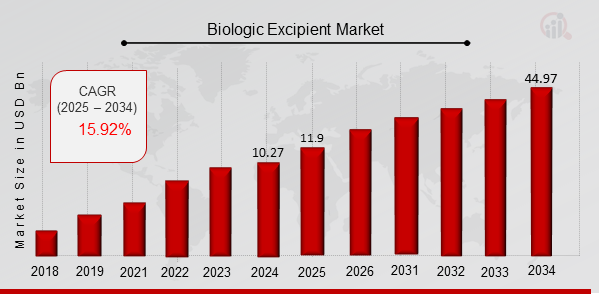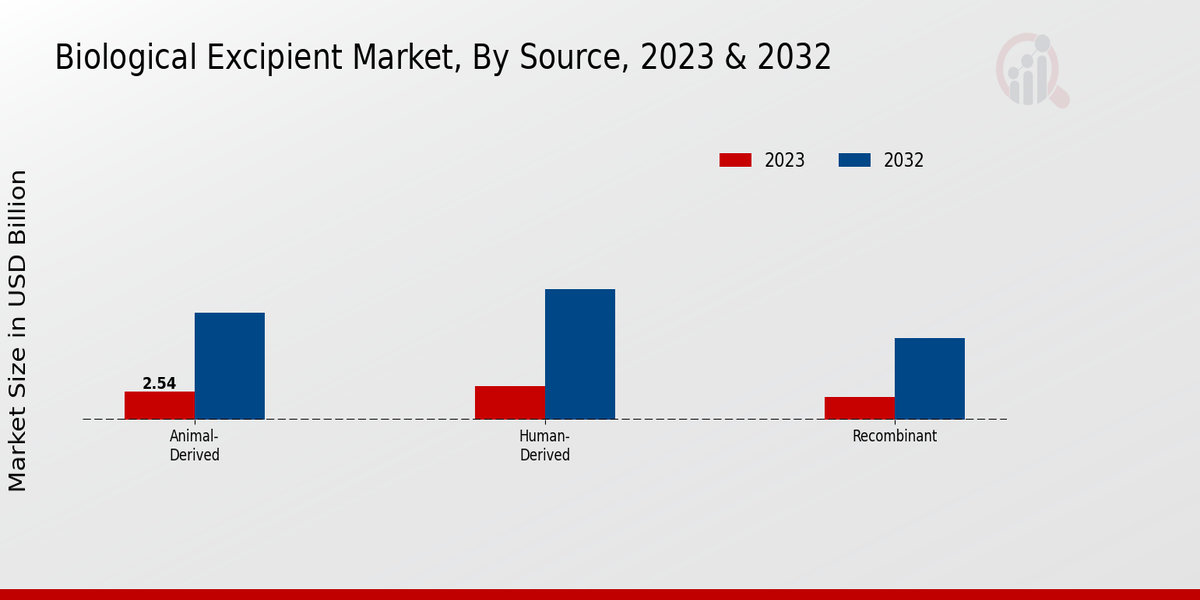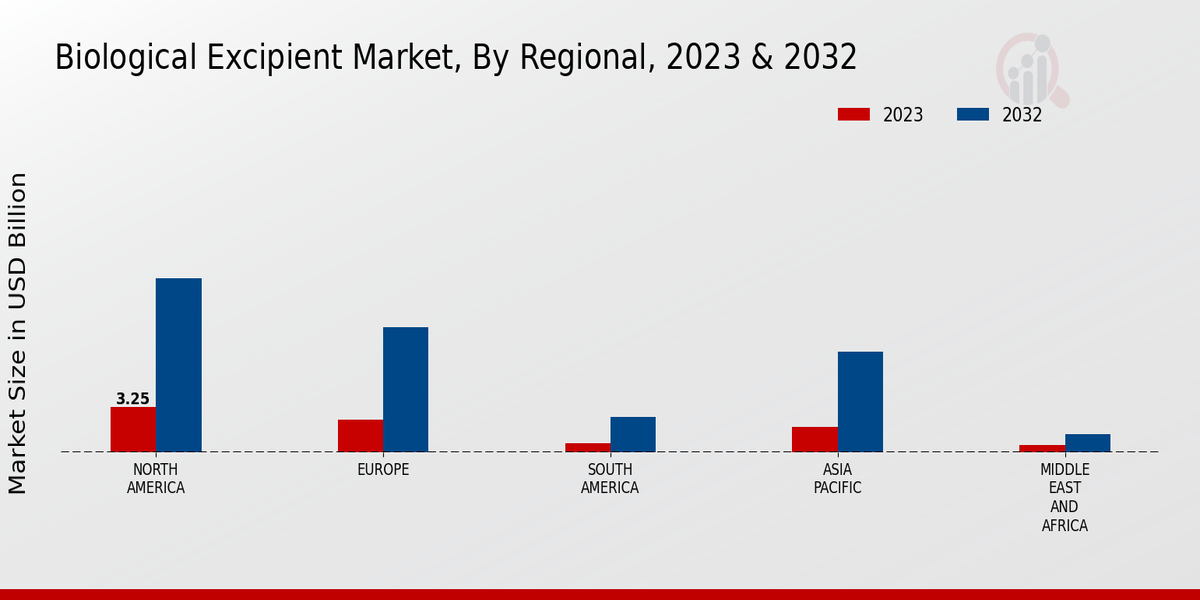Biologic Excipient Market Overview:
As per MRFR analysis, the Biologic Excipient Market Size was estimated at 10.27 (USD Billion) in 2024. The Biologic Excipient Market Industry is expected to grow from 11.90 (USD Billion) in 2025 to 44.97 (USD Billion) till 2034, at a CAGR (growth rate) is expected to be around 15.92% during the forecast period (2025 - 2034).
Key Biologic Excipient Market Trends Highlighted
Advancements in biopharmaceutical engineering techniques have led to an increasing demand for biologics, such as monoclonal antibodies, vaccines, and therapeutic proteins.
Biologic excipients play a crucial role in stabilizing biologics during formulation, storage, and delivery. The rising prevalence of chronic diseases and the increasing demand for personalized medicine are key drivers of the biological excipient market.
Recent trends in the market include a growing focus on biocompatibility, sustainability, and cost-effectiveness of biologic excipients. There is a shift towards using plant-based and animal-free excipients to meet the increasing demand for vegan and cruelty-free products.
Additionally, the development of novel excipients with enhanced functionalities, such as extended-release and targeted delivery, is creating new opportunities for market growth.

Source: Primary Research, Secondary Research, MRFR Database and Analyst Review
Biologic Excipient Market Drivers
Rising Demand for Biologics
The increasing prevalence of chronic diseases, such as cancer, autoimmune disorders, and diabetes, has led to a growing demand for biologics. Biologics are complex molecules derived from living organisms that have therapeutic properties.
They are used to treat a wide range of diseases, including cancer, rheumatoid arthritis, and Crohn's disease. The increasing adoption of biologics is expected to drive the growth of the biologic excipient market over the forecast period. The development of new biologics and the expansion of existing biologics into new therapeutic areas are also contributing to the growth of the market.
For instance, the approval of new cancer immunotherapies and the expansion of biologics for the treatment of autoimmune diseases are expected to drive the demand for biologic excipients. Additionally, the increasing use of biologics in combination therapies is further boosting market growth.
The growing adoption of biologics in emerging markets is another key factor driving the growth of the biologic excipient market. Emerging markets, such as China and India, represent a significant growth opportunity for the market.
The increasing healthcare expenditure and the rising prevalence of chronic diseases in these regions are expected to drive the demand for biologics and, consequently, the demand for biologic excipients.
Technological Advancements in Biologic Excipient Development
The development of new and innovative excipients is essential for the advancement of the biologics industry. Biologic excipients play a critical role in ensuring the stability, efficacy, and safety of biologics. Technological advancements in excipient development have led to the development of excipients that are more effective, more stable, and more compatible with biologics.
For instance, the development of novel excipients that can improve the solubility and stability of biologics has enabled the development of new and more effective biologics. Additionally, the development of excipients that can target specific delivery mechanisms has improved the efficacy of biologics.
The increasing focus on patient-centric drug development is also driving the demand for excipients that can improve the safety and tolerability of biologics. Ongoing research and development in the field of biologic excipients are expected to further drive the growth of the biologic excipient market.
The development of new excipients with improved properties and functionalities is expected to support the development of new and more effective biologics, thereby driving the growth of the market.
Supportive Government Policies and Regulatory Landscape
Government policies and regulations play a significant role in shaping the growth of the biological excipient market. Supportive government policies and a favorable regulatory landscape can encourage investment in research and development and promote the adoption of biologics and biologic excipients.
For instance, the increasing focus on biosimilars and the development of biosimilar pathways in various countries is expected to drive the growth of the biologic excipient market.
Biosimilars are similar to biologics but are developed and manufactured by different companies. The development of biosimilars has increased the availability and affordability of biologics, thereby driving the demand for biologic excipients.
Additionally, government initiatives to support the development and manufacturing of biologics in emerging markets are expected to further drive the growth of the biologic excipient market. The increasing focus on healthcare infrastructure development and the growing awareness of biologics in emerging markets are expected to create favorable conditions for the growth of the market.
Biological Excipient Market Segment Insights:
Biological Excipient Market Source Insights
The Biological Excipient Market is witnessing substantial growth, driven by increasing demand for biopharmaceuticals and biologics across various healthcare applications. The segmentation revealed valuable insights into the prominence of different categories, such as Animal-Derived, Human-Derived, and Recombinant excipients.
Among these, the Animal-Derived segment shined with a valuation of 2.54 USD Billion, which is expected to grow to 9.67 USD Billion by 2032, reflecting its majority holding in the market.
This segment's dominance was attributed to the widespread application of animal-derived components in therapeutic formulations, enhancing the biological activity necessary for effective drug delivery systems.
Meanwhile, the Human-Derived category represented a robust segment valued at 3.02 USD Billion in 2023 and projected to reach 11.73 USD Billion by 2032. This segment's significance lies in its potential for high safety profiles and compatibility in clinical settings, making it a preferred choice for many pharmaceutical developers.
Lastly, the Recombinant segment, valued at 2.07 USD Billion in 2023 and expected to grow to 7.39 USD Billion by 2032, also played a critical role in the market. Recombinant excipients are generating traction due to their ability to be genetically engineered and produced in a controlled manner, reducing variability and enhancing product consistency.
Each of these segments contributes uniquely to the overall landscape of the Biological Excipient Market, offering diverse applications and growth opportunities driven by technological advancements, regulatory support, and the rising prevalence of chronic diseases.
The growth drivers within this market are pushing for increased innovation in excipient development, with a keen focus on sourcing from these specific categories to meet the evolving needs of biopharmaceutical products.

Source: Primary Research, Secondary Research, MRFR Database and Analyst Review
Biological Excipient Market Form Insights
The segment encompasses various forms, including Liquid, Powder, and Gel, each playing a crucial role in the industry. Liquids are often favored for their ease of use and rapid absorption, making them vital in formulations where immediate bioavailability is essential. Powders, on the other hand, dominate due to their versatility and stability, catering to both pharmaceutical and biopharmaceutical applications.
Gels also hold a noteworthy position, especially in topical formulations, where they enhance user experience and drug delivery efficacy. Overall, the Biological Excipient Market revenue is driven by increasing demand for biopharmaceuticals, advancements in drug development, and the need for innovative excipients.
These trends collectively shape the market growth, making it essential for stakeholders to navigate the evolving landscape effectively. The Biological Excipient Market statistics illustrate the growing relevance of each form while highlighting opportunities and challenges in this dynamic industry.
Biological Excipient Market Function Insights
The Biological Excipient Market showcases a diverse Function segmentation that plays a crucial role in the efficacy and stability of biological products. This segment includes vital components such as Stabilizers, Emulsifiers, and Preservatives, each contributing significantly to the overall market dynamics.
Stabilizers are essential for maintaining the physical and chemical integrity of formulations, which supports the growing demand for stable biological products. Emulsifiers facilitate the mixing of hydrophilic and hydrophobic components, ensuring uniformity in formulations, which is increasingly important in various applications.
Preservatives, meanwhile, are critical for extending the shelf life of biological products by preventing microbial growth, thereby enhancing safety and efficacy. The Biological Excipient Market data reflects a steady trend toward biopharmaceutical formulations that require these functional ingredients, highlighting their importance.
As the industry progresses, challenges such as regulatory dynamics and sourcing natural excipients remain, yet they also present opportunities for innovation and growth within the Biological Excipient Market. Key trends indicate a heightened focus on sustainable and efficient excipients, suggesting a shift in consumer preferences that could drive market growth in the coming years.
Biological Excipient Market End-Use Application Insights
The Biological Excipient Market showcases significant growth potential primarily driven by its various End-Use Applications, notably in Vaccines, Protein Therapeutics, and Monoclonal Antibodies. This segment plays a crucial role in enhancing the efficacy and stability of biopharmaceuticals, reflecting the increasing demand for safe and effective therapeutic solutions.
Vaccines, as a predominant segment, facilitate the delivery of immunogenic components, thereby promoting health initiatives. Protein Therapeutics benefit from biological excipients through improved solubility and shelf life, which is vital for the management of chronic diseases.
Moreover, Monoclonal Antibodies represent a significant portion of the market due to their targeted therapeutic capabilities in treating various conditions, including cancers and autoimmune disorders. The increasing prevalence of these diseases, along with advancements in biopharmaceutical innovations, propels the demand for effective biological excipients.
As the market expands, it presents various opportunities for stakeholders to meet the rising needs in healthcare, while understanding market trends is essential for navigating growth drivers and challenges within the Biological Excipient Market.
Biological Excipient Market Regional Insights
The Biological Excipient Market is poised for substantial growth across various regions, reflecting diverse demands and developments. In North America, the market held a significant valuation of 3.25 USD Billion in 2023, which is expected to grow to 12.57 USD Billion by 2032, making it a dominant player due to advanced healthcare infrastructure and high pharmaceutical expenditure.
Europe followed with a valuation of 2.35 USD Billion in 2023, reaching 9.05 USD Billion in 2032, driven by increased research and development activities. The Asia Pacific region, valued at 1.85 USD Billion in 2023, is forecasted to expand to 7.27 USD Billion, highlighting its potential as a growing market due to rising healthcare access and manufacturing capabilities.
South America, though smaller, reached 0.65 USD Billion in 2023, projected to grow to 2.57 USD Billion as economies in the region are rapidly developing. Lastly, the Middle East and Africa segment, valued at 0.53 USD Billion in 2023, with expectations of reaching 1.33 USD Billion, was gaining traction through improving healthcare markets and increasing investments.
The market growth can be attributed to factors such as the rising prevalence of diseases and an increasing focus on biopharmaceuticals, creating opportunities for innovation and expansion in the Biological Excipient Market revenue.

Source: Primary Research, Secondary Research, MRFR Database and Analyst Review
Biologic Excipient Market Key Players And Competitive Insights:
Major players in the Biologic Excipient Market are constantly developing and enhancing their product offerings to meet the evolving needs of the market. Leading Biologic Excipient Market players are focusing on research and development to introduce innovative and advanced biologic excipients.
The Biologic Excipient Market development is driven by increasing demand for biologics and biopharmaceuticals, growing adoption of biologics in various therapeutic areas, and supportive government regulations. The Biologic Excipient Market Competitive Landscape is characterized by a mix of established players and emerging companies.
Pfizer is a leading player in the Biologic Excipient Market and a pharmaceutical company. They offer a range of biologic excipients, including cell culture media, serum-free media, and protein purification reagents. Pfizer has a strong focus on research and development and is committed to providing innovative and high-quality products to its customers.
Samsung Biologics is a leading competitor in the Biologic Excipient Market and a contract development and manufacturing organization. They provide a range of biologic excipient services, including cell line development, bioprocess optimization, and fill and finish. Samsung Biologics has a strong track record of success and is known for its high-quality products and services.
Key Companies in the Biologic Excipient Market Include:
- Evonik Industries
- Cargill
- Roquette
- Archer Daniels Midland Company
- Lonza
- Ingredion Incorporated
- CP Kelco
- Kerry Group
- Ashland
- Kerry Ingredients
- DowDuPont
- Novozymes
- FMC Corporation
- DSM
- Tate Lyle
Biologic Excipient Market Developments
The market growth is attributed to rising demand for biologics, increasing prevalence of chronic diseases, and technological advancements in the pharmaceutical industry.
Key industry developments include:
In 2023, Lonza announced the expansion of its biologics excipient manufacturing facility in Portsmouth, New Hampshire, to meet the growing demand for high-quality excipients.
In 2022, Merck KGaA launched a new range of excipients specifically designed for biologics, offering enhanced stability and functionality.
Several biopharmaceutical companies are collaborating with excipient manufacturers to develop innovative excipients that address specific challenges in biologic drug development and manufacturing.
Biologic Excipient Market Segmentation Insights
-
Biological Excipient Market Source Outlook
- Animal-Derived
- Human-Derived
- Recombinant
-
Biological Excipient Market Form Outlook
-
Biological Excipient Market Function Outlook
- Stabilizer
- Emulsifier
- Preservative
-
Biological Excipient Market End-Use Application Outlook
- Vaccines
- Protein Therapeutics
- Monoclonal Antibodies
-
Biological Excipient Market Regional Outlook
- North America
- Europe
- South America
- Asia Pacific
- Middle East and Africa
| Report Attribute/Metric |
Details |
|
Market Size 2024
|
10.27 (USD Billion)
|
|
Market Size 2025
|
11.90 (USD Billion)
|
|
Market Size 2034
|
44.97 (USD Billion)
|
|
Compound Annual Growth Rate (CAGR)
|
15.92 % (2025 - 2034)
|
|
Report Coverage
|
Revenue Forecast, Competitive Landscape, Growth Factors, and Trends
|
|
Base Year
|
2024
|
|
Market Forecast Period
|
2025 - 2034
|
|
Historical Data
|
2020 - 2024
|
| Market Forecast Units |
USD Billion |
| Key Companies Profiled |
Evonik Industries, Cargill, Roquette, Archer Daniels Midland Company, Lonza, Ingredion Incorporated, CP Kelco, Kerry Group, Ashland, Kerry Ingredients, DowDuPont, Novozymes, FMC Corporation, DSM, Tate Lyle |
| Segments Covered |
Source, Form, Function, End-Use Application, Regional |
| Key Market Opportunities |
Increasing demand for biologics Advancements in biotechnology Growing prevalence of chronic diseases Rising focus on biocompatibility Expansion of biosimilar and generic biologics market |
| Key Market Dynamics |
Growing demand for biologics, Advancements in biotechnology, Rising adoption of biosimilars, Increasing focus on biodegradability, and Regulatory incentives |
| Countries Covered |
North America, Europe, APAC, South America, MEA |
Frequently Asked Questions (FAQ) :
The Biological Excipient Market is expected to reach a value of 44.97 USD Billion by 2034.
The expected CAGR for the Biological Excipient Market from 2025 to 2034 is 15.92%.
North America is expected to dominate the Biological Excipient Market with a value of 12.57 USD Billion by 2034.
The market size of Animal-Derived biological excipients is projected to be 9.67 USD Billion by 2032.
Major players in the Biological Excipient Market include Evonik Industries, Cargill, Roquette, and Archer Daniels Midland Company.
The market value of Human-Derived biological excipients is estimated to be 11.73 USD Billion by 2032.
The Asia Pacific market for biological excipients is expected to reach 7.27 USD Billion by 2032.
Recombinant biological excipients are expected to have a market size of 7.39 USD Billion by 2032.
The market for biological excipients in South America is projected to increase to 2.57 USD Billion by 2032.
Challenges in the Biological Excipient Market include stringent regulatory frameworks and the need for technological advancements.

















